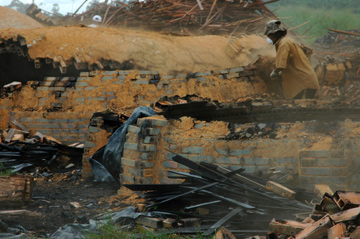An interview with Brazilian journalist Sergio Abranches on deforestation and climate
Regular columnist and co-creator of Brazil’s environmental news website, O Eco, Sergio Abranches has great credibility in Brazil’s eco-awakening. A professor of political science, Abranches uses his unique talents to reach a widening audience in Brazil for environmental, energy, and climate change news and discussion. He speaks expertly on any number of topics: from Amazonian deforestation to the current food crises to economic and political transformations for a warming world.
Calling himself an “activist of ideas”, Sergio Abranches spoke to Mongabay on many issues, including the current state of the Amazon. He calls for a zero deforestation program in five years though he is doubtful that Brazil’s current administration will tackle the issue effectively. As to the Atlantic Forest, where Abranches has worked for years, he states that well-meaning NGOs must work together towards a more comprehensive goal. In addressing REDD (Reduced Emission through Deforestation and Degradation) in regards to these Brazilian forests, he believes that any such program must include tangible benefits for local population, including education and technology, in order to be effective.
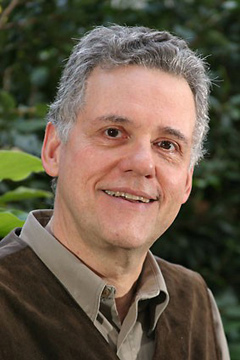
Sergio Abranches. Photo courtesy of O Eco |
Each of these conservation issues leads to climate change, which Abranches sees as global society’s overriding challenge. Abranches says that the world must approach climate change according to the worst-case scenarios: “We should pay attention not to contrarians’ critiques of the IPCC reports. We should be more concerned with the scientists that are saying that the IPCC underestimated some of the risks, because if they are right we may face an even greater challenge ahead. If the contrarians are right, we would not have to regret any mitigation measure we might have taken, because their side benefits in terms of less pollution, more sustainability and less future risk well overweigh their costs.” In the following interview, Abranches discusses the current state of climate change policy both globally and in the world’s biggest CO2 producers Brazil, the US, Europe, India, and China. For Abranches, no nation is doing enough: “There are some good ideas but what we need is effective concerted action. The major dilemma of climate change policy is that it is a global phenomenon that requires effective local action, and local actions, to be effective, might be globally synchronized and subjected to a global governance mechanism”.
Having just returned from a trip into the Amazon, traveling to Paragominas, Abranches ran into an operation of “Arc of Fire”. “Arc of Fire”, apart of the Brazilian government’s strategy to take illegal deforestation more seriously, is an uptick in police action against deforestation in the Amazon. Abranches witnessed the effects of new program first hand, and answers questions regarding his experience below.
REPORTING ON POLICE ACTION AGAINST DEFORESTATION IN BRAZIL
Mongabay.com: You were recently in the Amazon, following police operations in their new initiative ‘Arc of Fire’ to combat deforestation. Can you tell us about your experience?
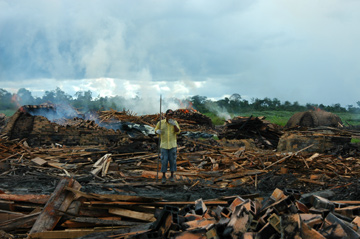
Destruction of charcoal furnaces during ‘Arc of Fire’. Photo by Sergio Abranches. |
Sergio Abranches: It was extremely interesting, because I was fortunate to be at the right place, in the right time, and it was a coincidence. I was planning to go to the city of Paragominas, at the margins of the Belem-Brasilia highway (Belem is the capital city of the Amazonian state of Para), to personally look into a local movement, led by the mayor, to stop deforestation. The operation “Arc of Fire” arrived two days before me. In the same day I got there, a group of Federal House and Senate members also arrived in Paragominas, to look at the operation. The operation is a joint action of the Federal Environmental Agendy (IBAMA), the State of Para Environment Secretary, the Federal Police and the National Force, a recently created special unit of the military to support police action in very violent areas. This convergence was enlightening. I talked to people from the lumber industry and they told me this was the toughest operation of the kind they have ever seen. And why was that so? Because, for the first time, they were confiscating all illegal timber found, besides fining the sawmills. Usually they would put an embargo on the timber, but leave it at the sawmills’ courtyards. Now it was hurting them economically. The politicians went back to the Federal Capital, Brasilia, to ask for an end to the operation. They were voicing the interests of illegal loggers.
But I saw a courtyard full of illegal logs, sawdust and timber residue. It was a very inefficient sawmill operation that produced far more leftovers than timber. A typical Amazonian sawmill. I also followed a police raid on very primitive illegal charcoal furnaces. They burn timber leftovers and wood from illegal logging to make charcoal to the pig-iron plants of the Carajás and Marabá, an iron ore and steel region.
Mongabay.com: What are the punishments for those caught illegally logging the forest?
Sergio Abranches: There are heavy fines and they can be prosecuted and sent to jail. The sawmill raided by the police that I documented for O Eco got a US$ 450,000.00 fine. The problem is that most of them never pay their fines and there are no consequences. Now the federal attorneys are making sure that these fines will be paid. We’ll have to wait and see.
Mongabay.com: Do you think the new police action is having an effect? If so, is this the end of the Wild West in Mato Grosso?
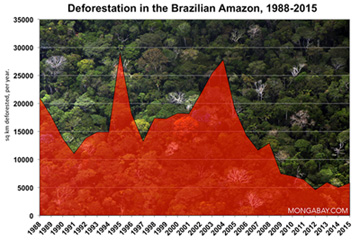
|
Sergio Abranches: There is an aspect of the whole operation that worries me. It was planned very much as a show off to countervail the fact that the Federal Government has disregarded all signs that deforestation was regaining momentum in the Amazon, after three years of steep falls. The very first signs came out of independent satellite monitoring, by an Amazon think-and-do-tank Imazon, as early as May 2007. I then wrote that the government was making a big political mistake to deny the fact. Soybean and beef prices were up after a three-year long crisis, the pressure on the forest was back, it was time to act. Government environmental authorities called me to say that it wasn’t happening. The government denied it for months, and only admitted that deforestation was on an upwards trend after the Bali Climate Convention. It set up the operation to compensate for months of inaction. When the police leave, illegal activities will resume, unless the government has a more coherent, permanent set of anti-deforestation policies. But government policy for the Amazon is very contradictory. The ministry of Agriculture criticizes anti-deforestation raids such as the “Arc of Fire”. President Lula’s dearest program, the Program for Accelerating Development is a real threat to the integrity of the Amazon forest, because it plans to build asphalt roads and several huge hydropower plants there. The roads are one of the main inducements to new settlements and forest clearing there is. Any satellite photo shows the fishbone pattern of deforestation, having roads as the backbone. The Amazon needs a new development agenda, one based on a zero-deforestation clause.
I don’t think we are going to see the end of the Wild West in Mato Grosso too soon. I have seen some signs that the Wild Frontier mentality is starting to decline in the State of Pará. I heard a lot about a plan for zero illegal-deforestation. It is not the ideal zero-deforestation principle I think we’ll have to pursue, but it is an emergent, very initial movement towards illegal logging.
Mongabay.com: Can you describe the ‘Pact for Zero Deforestation’?
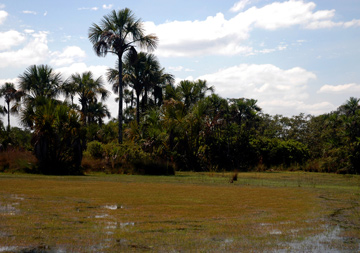
Veredas are swampy plains between hills and rivers in the Cerrado. Photo by Sergio Abranches. |
Sergio Abranches: A pact for zero deforestation would be a broad agreement among governments, corporations, all the politically active elite of the Amazon region, to stop all transactions of any kind of product that comes from illegally occupied land and from deforested areas. Two years ago soybean producers, trading companies and major importers signed an agreement not to accept soybean from newly cleared land. It has significantly reduced the contribution of soybean production to this new cycle of raising deforestation. Most of the areas where deforestation is increasing are either for pasture or land-reform settlements. The latter is another contradiction of official policy: the federal land-reform agency has become a major driver of deforestation.
ON THE AMAZON
Mongabay.com: What is your view of Brazil’s current policies towards both the exploitation of the forest and its preservation?
Sergio Abranches: As I said the Federal Government does not have a coherent policy for the Amazon. Brazilian federalism is too centralized; the Federal Government has too much power. State governments are not able to single-handedly solve the problems of law enforcement. The land-rights disorder, that is the main alibi for generalized illegal activity in the Amazon, depends entirely on the federal government. The state governments of Amazonas and Pará are trying to implement sound preservation policies each on their own way. But the Amazon needs far more. It needs a new agenda for development, based on education, science and technology. Technology should be applied to monitor, preserve and use its biodiversity in a sustainable way. I used to say that the Amazon problem has three main pillars, each representing in fact more development, none an obstacle to development: rule of law and improved democracy; good education, science and technology; corporate social and environmental responsibility.
Mongabay.com: Do you see change in the air politically and/or socially regarding the deforestation of the Amazon?
 The Cabybara, Earth’s largeset rodent. Photo by Sergio Abranches. |
Sergio Abranches: I see three emerging sources of change. The first one is a negative one: fear. I sense fear among the larger soybean and beef producers, and among certified wood producers. Fear of a new environment-based wave of protectionism that would ban Amazon products from high-quality world markets. The second and third ones are positive. There is a growing public awareness about the risks of climate change and the contribution of Amazon deforestation to GHG emissions. Public pressure is a necessary, though not always sufficient, condition for effective political action. Finally several segments of the Amazon society are craving for law and order, for development that preserves the forest’s delicate balance. It is an emerging and enlarging group of scientists, technically trained professionals, business people, the more illustrated political elite, but also common citizens. Workers in illegal charcoal furnaces as well as hired-hands for illegal logging told me they thought deforestation was a very bad thing and should be stopped. They are a minority but I would say that, given the global and domestic macro-trends that point to the foreseeable future, it is a winning sentiment. Sooner or later it will become a majority. The problem is time. It is important to reduce the pace of deforestation to give time for the completion of this process of agenda-building and consensus-seeking to achieve zero-deforestation.
Mongabay.com: How do you feel about REDD, the Reduced Emissions through Deforestation and Degradation program brought forward during climate negotiations? Could such a program be helpful in preserving the Amazon?
Sergio Abranches: I think it might help a lot, provided it brings real benefits to the local populations. Real benefits will require good management and investment of the financial resources to be obtained from REDD-like programs. Good governance and accountability will be essential to the success of such programs.
Mongabay.com: What must a program like REDD entail to be effective in the Amazon?
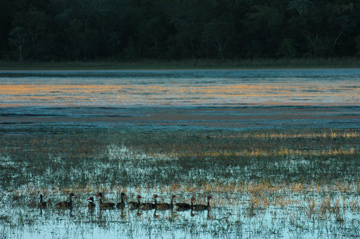 Birdlife in the Pantanal, Brazil’s giant wetland. Photo by Sergio Abranches. |
Sergio Abranches: I would very much recommend using a fair share of the resources to create an investment fund to finance education, science and technology to develop the basis for a new pattern of development in the Amazon. I fear for the success of such programs if they become entirely dependent on governments. “Governmentalization” and “politicization” should be avoided at all costs. I’d rather see these programs under new governance mechanisms, that do not exclude governments, but that are essentially independent, and include other forces, especially for their monitoring and evaluation. Either they’ll add strength to the emerging transformative forces in the region, or they’ll fail to help preserving the forest. I can’t figure out how such a mechanism would succeed as voluntary government programs. They must have binding targets and independent monitoring.
ON THE ATLANTIC FOREST
Mongabay.com: You’ve spent a lot of time working on issues regarding the Atlantic Forest. Considering the forest is already less than 10 percent its historical size, how is its conservation different from that of the Amazon?
Sergio Abranches: Part of the conservation effort is the same that applies to the Amazon: establishing the rule of law, good governance, fighting corruption, making the conservation units – both at the federal and state levels – work more effectively. That requires investment, trained people, equipment and technology. Today we have the technology to monitor all conservation units through satellite, to help preventive action against logging, wildfires, and hunting. Good governance would reduce pressure on the border of conservation units by disorderly urban advance. But, as you said, there is only 7 percent remaining of the Atlantic forest. It requires a bold, ambitious recovery program, a concerted action towards reforestation, especially at the river basins, and the creation of ecological corridors that are very important for the preservation of wildlife.
Mongabay.com: Are there any plans in place by the Brazilian government or local NGOs to re-establish large portions of the Atlantic Forest?
Sergio Abranches: There are several private and NGO programs that are promising, but to me their main flaw is that they are independent from each other, even competing for the same resources. I would rather have a coalition joining together all active forces struggling to save and enlarge the Atlantic Forest, including all financing agents, to implement a concerted, planned action. I would also like to see public-private partnerships to manage conservation units. I think that would significantly increase governance and efficiency in the management of conservation units.
Mongabay.com: What could the Atlantic Forest gain from a program like REDD?
Sergio Abranches: As far as the concept of reduced deforestation applies, I don’t think it would have a major role to play in the Atlantic Forest. There is deforestation but not on a scale comparable to what happens in the Amazon, the savanas – Cerrado – of midwestern Brazil and the wetland – Pantanal. But I see a lot of possibilities for other mechanisms of the carbon market to benefit the Atlantic Forest.
Mongabay.com: How does the Brazilian public view their forests? Have you seen these views changing?
Sergio Abranches: A poll conducted by O Eco a year ago showed that Brazilians already see deforestation as our major environmental problem. And the Brazilian public does correlate deforestation and climate change. There is an emerging sense that we need to change the way we treat our forests. But it is not yet enough to create the amount of public pressure needed to change the present order of things.
ON CLIMATE CHANGE
Mongabay.com: You have written about climate change in the past. What is your view on the urgency and seriousness of the issue?
Sergio Abranches: If we look at climate change from a risk perspective, it is not only extremely serious, but it also is the most urgent matter at hand for every country to act upon. When I discuss climate risk I try to show that it is never wise to treat risk on the basis of the best-case scenario. One must look at it through the lenses of the worse-case scenario, of what we ought to prevent from happening, to be able to identify the appropriate measures required. This means we should pay attention not to contrarians’ critiques of the IPCC reports. We should be more concerned with the scientists that are saying that the IPCC underestimated some of the risks, because if they are right we may face an even greater challenge ahead. If the contrarians are right, we would not have to regret any mitigation measure we might have taken, because their side benefits in terms of less pollution, more sustainability and less future risk well overweigh their costs. If the IPCC consensus proves to be true, we would have done right. So, to me, there is no sound argument for not taking mitigation actions.
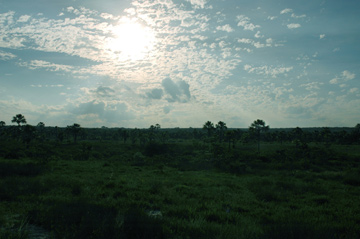 The great bushy dry plains of the Grande Sertao, part of the Cerrado ecysystem. Photo by Sergio Abranches. |
We are not doing what we must do yet, but I think we will eventually. I think the political scenario for global climate politics and policy will be very different in 2015, from what it is right now. We will very likely muddle-through for the next two years. The political process to form a global winning coalition to support new global climate policies will only accelerate from 2010 onwards. There will be no real progress towards an agreement among the developed countries, while the US is still under the present administration. Among the emerging nations, there are three main obstacles: China, India and Brazil.
The Chinese authorities know their country is moving fast towards an environmental collapse in every dimension: air quality, water supply, energy security, food security. Their interest on Tibet today has much less to do with Mao’s dream of a unified China, than with clean water supply. China has been slower in climate change diplomacy than in investing on the environment. Independently of the incentives related to the Olympic Games, environment-oriented investment to reduce pollution, develop renewable energy sources and recover waterways has been growing very fast over the last three years. The environment authorities were upgraded in the power hierarchy, an important sign in the Chinese authoritarian regime.
India is very vulnerable to short-term climate change risk. There is some disquieting scientific evidence that the summer monsoons could reduce intensity or even disappear in the short-run. If that happens, summer days will become hotter, drier and a significant portion of their rice production would be lost. I have discussed climate change issues last week with an influential military and strategic analyst from India, and he told me that there is a growing concern in his country about climate change, the melting in the Himalayas, the major source of water for the Ganges and Brahmaputra valleys, and the cost of adaptation.
Mongabay.com: What is Brazilian government’s current position on climate change? Do you think most Brazilians agree or disagree with their government on this issue?
Sergio Abranches: In Brazil, I think it will be like the US: there will be no real progress under the present administration and it is still too early to say if the 2010 elections will bring change in this area. The government opposes mandatory emissions targets and tries to convince other countries it is able to implement effective voluntary mitigation and anti-deforestation policy. But it fails to convince even the Brazilian public.
Also like in the US the public is increasingly more supportive of climate change mitigation policies. Our first major move should be to adopt the zero-deforestation goal to be achieved within the next 5 years.
Mongabay.com: What are some of the best solutions that you have seen in combating climate change?
Sergio Abranches: Actually I don’t think we already have good solutions. The EU, for instance has some very interesting plans, but EU climate change intentions have so far fallen short of effective action. There are some good ideas but what we need is effective concerted action. The major dilemma of climate change policy is that it is a global phenomenon that requires effective local action, and local actions, to be effective, might be globally synchronized, and subjected to a global governance mechanism: a mechanism of governance without government.
I don’t think we will succeed in reaching such an agreement in the general assembly model adopted by the Climate Change Convention and the Kyoto Protocol. It is too heterogeneous and too large an assembly to allow for meaningful unanimous solutions. There are too many veto players with unequal participation in GHG emissions. I think we will need to first move towards an agreement between the large developed emitters, the G-8 plus South Korea and Australia, and the large emitters with emerging economies and/or forest power, China, India, Brazil, Mexico, South Africa, and Indonesia. Once such an agreement is reached, it could be presented to the Climate Convention as a strong inducement to be written into the post-Kyoto Protocol agreement. An agreement of that breadth would require an independent global climate agency to take care of its implementation and monitoring.
Mongabay.com: How do we balance resources for human welfare, especially of the poorest nations, and combating climate change?
Sergio Abranches: It varies very much depending on the energy matrix of each country. Even among the emerging economies the cost of transition towards a low carbon economy will vary. China and India are too coal-dependent, for instance. Moving towards renewable and clean energy at the pace that will be required, and on a scale compatible with their energy needs is a major endeavor. There are people that do not see any feasible alternative other than increasing the participation of nuclear energy in their energy matrix. In Brazil, more than 70 percent of its electricity supply comes from hydropower. Our major contribution to GHG emissions comes from deforestation (70 percent of total emissions). There are no sacrifices associated to ending deforestation in the Amazon, only gains. More than 80 percent of total deforestation is illegal. Illegal deforestation is very often related to forms of labor that fall within ILO’s concept of forced labor. Ending illegal deforestation in Brazil corresponds to improving the quality of democracy, fully respecting human rights and eliminating illegal and illegitimate sources of economic gain. There is plenty of evidence that any social benefit from deforestation is short-lived. Usually, economic activity decays with the exhaustion of soils and leave behind a trail of sand and poverty.
  |
Regarding the poorer countries my major concern is with the fact that the world is not discussing adaptation with the necessary emphasis and sense of urgency. Adaptation has been receiving even less attention than mitigation. All countries will have to adapt sooner or later. Several developed countries will be severely hit by the amount of climate change that is unavoidable, because of emissions that accumulated over the last three or four decades. We won’t be able to do anything to reduce the greenhouse effect due to what is already in the atmosphere. But the burden of adaptation will fall heavily upon the poorer nations and upon the poorer sectors of the wealthier societies. Climate refugees will become a major problem if we do not take preventive adaptation measures even faster than we try to mitigate emissions. We should be already trying to reduce the risk of a dreadful scenario of increasing epidemics, famines, and water and food wars. Underdevelopment countries have an advantage the multilateral development and aid agencies should be considering: they don’t need to follow the same high-carbon development path developed countries did in the 20th century. Aid, investment, and technology transfer could be used to help them develop a low-carbon economy geared to improve human development, rather than 20th century consumerism, as is happening in Brazil, China and India.
I think that a large part of the climate deadlock, apart from the remaining strength of the political interests vested in the status quo, is due to the fact that we are still looking at climate change policy as a matter of sacrifice. We should look at the risks revealed by the worse-case scenario, but as far as the solutions are concerned, they should be framed not negatively, but positively, in terms of a new pattern of development, new low-carbon patterns of production and consumption, that actually lead to more human welfare, to the elimination of several sources of illness, such as poor air quality, bad water, open garbage pits. Instead of discussing only the limits to development under the present model, we should be debating and studying with all the emphasis possible, the strengths and larger benefits of these new models of low-carbon development and how they actually can be more beneficial to the majority, than the present ones have been. We should not look at improving the 20th century models; we should be designing totally new 21st century models.
PERSONAL
Mongabay.com: I’ve heard you described as a journalist, a political scientist, a sociologist, an environmental commentator, a professor, and an activist. How do you describe yourself?
Sergio Abranches: I don’t see myself as an activist, at least in the conventional sense of being part of a social or political movement, but I try to be an activist of ideas. I like to propagate and debate innovative or sound ideas about how to change society and economy towards more democracy, social justice and a low carbon pattern of production and consumption. I think my main activity today could be described as an author of content for different kinds of public and media. I write daily on political and environmental affairs to the sites O Eco and Risco Político (Political Risk) and I also frequently write articles to be published by newspapers and magazines. I contribute to some on a regular basis, such as for the Brazilian edition of Scientific American. I also do a daily commentary on the Brazilian all news radio network CBN, on “ecopolitics”. I am trying to use my academic training in a way I can reach a wider audience, to show how global climate change affects and is affected by economic, social and political issues.
Mongabay.com: Please tell us about your column on the website O-Eco?
Sergio Abranches: Five years ago, I was talking to a friend of mine, an excellent professional journalist and photographer, Marcos Sá Corrêa, about the creation of a site of journalism to cover the many aspects of Brazilian reality that the conventional press was disregarding. And the major area of neglect was the environment. Marcos has a long career of writing on the environment, especially on conservation issues. He was having a similar conversation with Manoel Francisco Brito, another first rate journalist. We got together and decided to create O Eco. We designed O Eco also to show young journalists how to find the “environmental angle” in any story, and we make it a rule to work with a group of trainees, that we hope, after some time, will go to mainstream journalism with this eye to see the environment in any aspect of social life. I realized that my main role would be to bring science and journalism closer together, and decided to write an op-ed column. Today most of my columns address climate change and energy matters. In Brazil, one cannot talk about mitigating GHG emissions and climate change without looking into the Amazon and deforestation. The Amazon entered my agenda and I am dedicating a large part of my time to study and write about the Amazon.
Mongabay.com: Any plans to have a version of the site available in English?
Sergio Abranches: Yes, we are working on it. We are redesigning it and looking at how to edit an English version.
Mongabay.com: Do you have a favorite place in Brazil to visit?
Sergio Abranches: I am very fond of three endangered places in Brazil: the Savana (Cerrado), especially a Conservation Unit in my home state, Minas Gerais that preserves the site of the Brazilian novel I love the most, Grande Sertão Veredas; grande sertão is the wide open bushy savana, and veredas are formed around rivers and fountainheads and have a denser and greener vegetation; an area of the Atlantic Forest, in the Rio Doce Valley, also in my home state, particularly the reservation where a group led by Karen Strier, professor at Wisconsin, studies the Muriquis, primates with a lot of charisma; and the Wetlands (the Pantanal), our larger wildlife sanctuary. But as far as looking for relevant content related to my present agenda on a low-carbon, less unequal and more accountable model of development, the place to be is the Amazon and its has plenty of very beautifull places. To find a durable solution to deforestation in the Amazon is the first step in designing a winning model of development for 21st century Brazil.
Mongabay.com: What do you say to students who would like a career in environmental journalism?
Sergio Abranches: That they should not view themselves as “niche journalists”, they should regard themselves as journalists with a view to the environment. The more we have a clearer environmental angle in the coverage of the economy at large, political and diplomatic affairs, city life, travel, business, the sooner people will understand that the environment, and climate change especially, is already and will become even more strongly the determining factor of 21st century life.


